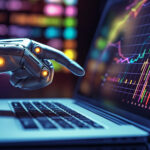Your Survival Guy’s survival stock for you today is a company using blockchain technology to help bring you a better product. You may have heard of it: McDonald’s. Want to know how those two sizzling Big Mac patties get to you? Well, one supplier, Golden State Foods, uses blockchain through IBM’s Food Trust (see below).
But before we dig into this feast, what you and I need to know is: does it pay a dividend? And the answer is a big YES—since 1976. Like hot french fries dipped in ketchup—one, after another, after another.
And one year before that dividend began, some clever operator in Arizona cut a hole in the side of his building, creating the first drive-thru. Who would have thought serving customers from a window would be a thing? In an interview with McKinsey, McDonald’s CEO Chris Kempczinski talks about the three D’s: Drive-thru, Delivery, and Digital. (I’ll add a fourth to the order: DIVIDENDS, please.) From McKinsey:
Chris Kempczinski: Prior to 2017, delivery was a $1 billion business for us, largely in Asia. By the end of 2019, delivery sales were over $4 billion and we continued to see very strong growth in 2020. Additionally, we’ve been able to expand the number of restaurants offering delivery to more than 30,000. Much of it is done through third-party operators, like Uber Eats, DoorDash, Just Eat Takeaway, and Deliveroo, but in some markets—like parts of Asia, Australia, and Germany—we’re actually experimenting with hybrid models, including self-delivery.
As for drive-thru, we offer it in 95 percent of our US restaurants and nearly 65 percent globally. The thing about drive-thru is that no matter how good you are, you can always get better. In our top markets, our drive-thru service times are now about 30 seconds faster than they were two years ago. We think we can get even faster—and we’re also thinking about ways that the digital experience might work in drive-thru. So, for example, if you are a customer using the app, maybe you have a dedicated drive-thru lane.
How McDonald’s restaurant layouts might change postpandemic
We expect to roll out our loyalty program, called MyMcDonald’s Rewards, in the US later this year and in all our major markets over the next couple of years. The MyMcDonald’s platform is essentially an ecosystem of all the things that you can do via digital touchpoints with McDonald’s—think mobile ordering, payments, delivery, rewards, or deals. I’m excited about all the opportunities for us there.
One thing we’ve learned during the pandemic is that if we simplify our business and focus on what we’re great at—like drive-thru and our core menu items—there’s a fantastic benefit for our customers. We’ve seen our customer service scores go up across the globe. We’ve seen our productivity and our restaurant-level margins improve. It was a great reminder about the embedded cost of complexity in our P&L. It wasn’t obvious where that complexity was, but now that we’ve discovered it, we’re committed to keeping our business simple.
Postpandemic, I don’t think dine-in will come back to where it was. In Europe, dine-in was 65 percent of our business in some markets; it might be less postpandemic. So dine-in will still be important, but I think takeaway channels, like delivery, drive-thru, and order ahead with curbside pickup, will stay elevated for the foreseeable future.
Another “D” worth remembering? DISTRIBUTION. McDonald’s is a master at supply chain—it has to be with over 14,000 locations scattered around the U.S. And, with all those locations, 95% have a drive-thru—comprising 90% of its business during the pandemic. Who do you think is well-positioned to handle the next one? And since we’re talking survival, who do you think was there for the front-line workers in the thick of things? And who do you think has the most pull to get supplies—your local food truck?
Let’s go back to 2018 when McDonald’s literally reinvented its staple Quarter Pounder (w/ cheese please!), choosing to eschew frozen patties for fresh, never frozen, ones. Already a monster in terms of “cold chain distribution,” it needed to guarantee the quarter lbs. were never frozen and ALWAYS delivered mouthwateringly hot with pickles, mustard, onions, and ketchup, all within 14-days—or they weren’t served at all. It was a huge success. And with blockchain, I’d imagine they know a thing or two about, for example, which truck broke down or made great time with its delivery. Don’t you?
Action Line: Remember, when it comes to technology if it’s free—you’re the product (Google and Facebook). There are more ways to harness blockchain than bitcoin. For me, I like companies that invest their own capital to harness tech and bring value to your table: just as long as they pay that McDividend.
P.S. Watch how a major food distributor assures its customers about hamburger quality and freshness.
IBM writes:
California-based Golden State Foods (GSF) provides hamburger patties, sausage, produce and an array of other products to the food industry, retail outlets and quick service restaurants around the world. Its customers include 100 brands and, on any given day, its products are served to customers at 120,000 restaurants.
Food safety and quality are core to the company’s internal processes and brand reputation. But tracking exactly what happens to beef from farm to fork in near real-time is not easy for any company. The beef supply chain behind every hamburger is highly segmented, involving ranches, feedlots, packers, processors, distribution centers and restaurants.
Each business keeps its own meticulous records. Software systems designed to connect them, however, typically require a lot of manual inputs, are prone to errors, and encounter inherent delays. And those systems are not designed to track one of the most essential elements in the beef’s journey—the temperature at which it’s kept.
GSF partnered with IBM to pilot a solution that used radio-frequency identification (RFID) tags to automatically track fresh beef’s movement through one of its hamburger patty production plants to shipping, to the distribution center and finally delivery to one of three restaurants. IoT devices monitored the temperature at strategic points in the process, and automatically uploaded it to IBM Food Trust’s blockchain, making the data available in near-real time to everyone using it.
GSF’s pilot demonstrated the importance of improved precision and speed in the supply chain, including benefits such as reduction in shipping and labor costs, less waste, higher quality, and improved product rotation management and inventory optimization.
E.J. Smith - Your Survival Guy
Latest posts by E.J. Smith - Your Survival Guy (see all)
- Rule #1: Don’t Lose Money - April 26, 2024
- How Investing in AI Speaks Volumes about You - April 26, 2024
- Microsoft Earnings Jump on AI - April 26, 2024
- Your Survival Guy Breaks Down Boxes, Do You? - April 25, 2024
- Oracle’s Vision for the Future—Larry Ellison Keynote - April 25, 2024

















